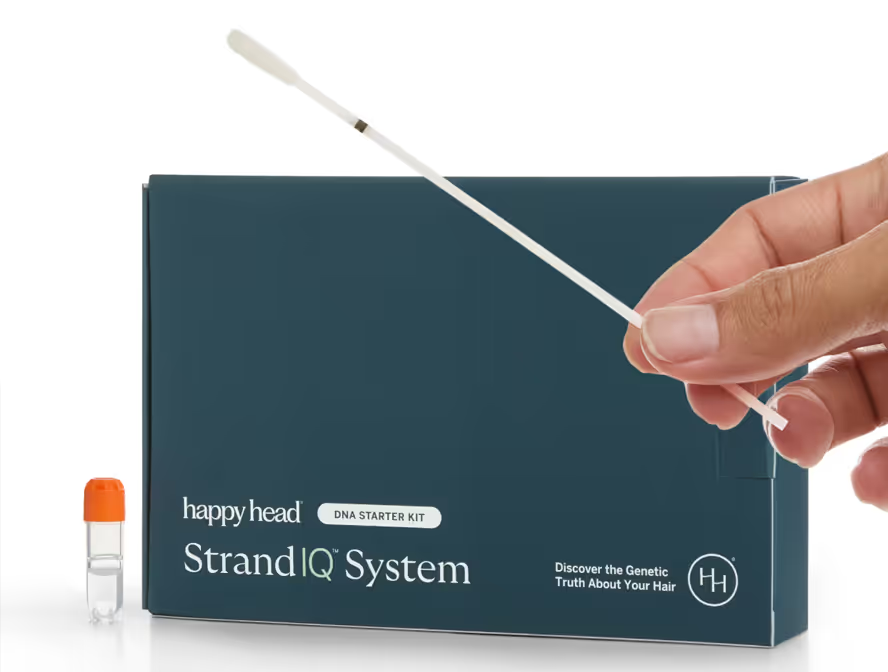Vitamin D does more than support bones and immunity—it directly influences hair follicle activity. Hair follicles contain vitamin D receptors (VDR), which help trigger the shift from resting (telogen) to active (anagen) growth. When vitamin D is insufficient, hair may stay in the resting phase longer, leading to slower growth, shedding, or thinning.
Genetic variants in the VDR gene or related transport proteins can reduce how effectively your body uses vitamin D. This may increase your risk of telogen effluvium or even autoimmune hair loss conditions like alopecia areata, where follicles are more vulnerable to immune system misfires. Monitoring and supporting vitamin D is essential for long-term scalp and hair health.
How Genetics Affect Vitamin D and Hair Health
Even if you get sunlight and eat a varied diet, weak vitamin D processing can limit the amount your body activates and delivers to your hair follicles. Signs of low or inefficient vitamin D may include:
- increased hair shedding or delayed regrowth
- diffuse thinning rather than patchy hair loss
- slower recovery from seasonal shedding or stress-related shedding
- heightened risk for inflammatory or autoimmune scalp conditions
Understanding your genetic profile allows you to work with your Happy Head care team to personalize your vitamin D intake and lifestyle strategies for healthier hair and scalp resilience.
Recommendations Based on Genetic Risk
These recommendations can help support vitamin D levels and healthy hair growth, tailored to your body’s ability to process and retain the nutrient.
Low Risk: Maintain Vitamin D Through Sunlight and Diet
If your Happy Head StrandIQ genetic analysis indicates you are at low risk for weak vitamin D processing, maintaining scalp and hair health can generally be achieved with a balanced diet and minimal sun exposure. These recommendations focus on sustaining adequate levels year-round.
- Brief sun exposure
A few minutes of daily sunlight is enough for most people to produce vitamin D—even while using sunscreen. - Eat vitamin-D-rich foods
Include egg yolks, cheese, beef, and fatty fish such as tuna, mackerel, sardines, and herring. - Include fortified foods
Opt for milk, breakfast cereals, soy drinks, and orange juice to maintain consistent intake.
Medium Risk: Optimize Intake and Monitor Supporting Nutrients
With moderate genetic risk, your body may be less efficient at processing or utilizing vitamin D. The following strategies emphasize optimizing intake, improving absorption, and preventing gradual deficiencies that can affect hair growth.
- Continue sun-safe habits
Short daily sun exposure with sunscreen is sufficient for vitamin D synthesis. - Diversify sources
Include mushrooms, egg yolks, cheese, and fatty fish, plus fortified tofu and plant-based milks. - Check related minerals
Calcium and magnesium support vitamin D metabolism. Low levels can reduce effectiveness, so discuss testing with your provider. - Consider supplementation
If diet and sun exposure aren’t enough, your Happy Head care team can guide you through safe dosing recommendations.
High Risk: Prioritize Bioavailability and Medical Guidance
A high-risk profile suggests that vitamin D processing efficiency may be significantly reduced, which can impair the hair growth cycle. These recommendations prioritize consistent intake, bioavailability, and professional monitoring to help protect follicle function and scalp health.
- Combine all strategies
Ensure regular dietary intake from natural and fortified sources and brief sun exposure for natural production. - Support absorption
Monitor calcium and magnesium levels with your doctor, as deficiencies can hinder vitamin D activation. - Explore targeted supplementation
If your genetic risk is high—or if you notice continued hair loss—your provider may recommend vitamin D3 supplements or monitored therapy. - Monitor hair and scalp health
If shedding or thinning persists, lab testing and personalized nutrition may help prevent progression.
Supporting Hair Growth With Vitamin D
Healthy vitamin D levels create an environment where hair follicles transition efficiently into the growth phase, supporting denser, more resilient hair. Whether your risk is low or high, combining nutrient-rich foods, brief sun exposure, and professional guidance helps protect scalp health and promote hair vitality.
Resources
StrandIQ SNP Marker Count: 79
StrandIQ Genes for Trait:
ACTE1P, ALDH1A2, AMDHD1, APOC1, APOC1P1, APOE, ARNT, BUD13-DT, CCDC93, CD248, CELSR2, CETP, COG5, CTXND2, CYB561, CYP2R1, DHCR7, DHCR7-DT, DOCK7, DSG1, DSG1-AS1, EBF2, GATA4, GC, GCKR, GNGT1, GPR22, HMG20A, HSD17B11, HTR5BP, KIRREL2, KLK10, KLK9, LINC00536, LINC01595, LIPC, LIPC-AS1, LMCD1, LMCD1-AS1, MAT1A, METTL25, MORN1, MTARC1, NADSYN1, NCAN, NF1P12, NPAS2, NPHS1, PADI1, PDE3B, PEAK1, PSMA1, PSRC1, RER1, RNA5SP358, RNA5SP359, RPL17P11, RPL39P34, SLCO1B1, SMARCA4, SMCP, SULT2A1, TFDP2, TM6SF2, TNFAIP8, TPRX2, UGT1A10, UGT1A4, UGT1A5, UGT1A6, UGT1A7, UGT1A8, UGT1A9, UGT2B7, WIPI1, XPNPEP3, ZNF701, ZNF808, ZPR1
References:
Ahn, J., et al. (2010). Genome-wide association study of circulating vitamin D levels. Human Molecular Genetics, 19(13), 2739–2745. PMID: 20418485.
Amin, H.A., Drenos, F. (2021). No evidence that vitamin D is able to prevent or affect the severity of COVID-19 in individuals with European ancestry: a Mendelian randomisation study of open data. BMJ Nutrition, Prevention & Health, 4(1), 42–48. PMID: 34308111.
Anderson, D., et al. (2014). Genome-wide association study of vitamin D levels in children: replication in the Western Australian Pregnancy Cohort (Raine) study. Genes and Immunity, 15(8), 578–583. PMID: 25208829.
Berry, D.J., et al. (2012). Evaluation of genetic markers as instruments for Mendelian randomization studies on vitamin D. PLoS One, 7(5), e37465. PMID: 22629401.
Jiang, X., et al. (2018). Genome-wide association study in 79,366 European-ancestry individuals informs the genetic architecture of 25-hydroxyvitamin D levels. Nature Communications, 9(1), 260. PMID: 29343764.
Kim, Y.A., et al. (2021). Unveiling genetic variants underlying vitamin D deficiency in multiple Korean cohorts by a genome-wide association study. Endocrinology and Metabolism (Seoul), 36(6), 1189–1200, 1241. PMID: 34852423.
Lasky-Su, J., et al. (2012). Genome-wide association analysis of circulating vitamin D levels in children with asthma. Human Genetics, 131(9), 1495–1505. PMID: 22673963.
Manousaki, D., et al. (2020). Genome-wide association study for vitamin D levels reveals 69 independent loci. American Journal of Human Genetics, 106(3), 327–337. PMID: 32059762.
Moy, K.A., et al. (2014). Genome-wide association study of circulating vitamin D-binding protein. American Journal of Clinical Nutrition, 99(6), 1424–1431. PMID: 24740207.
Wang, T.J., et al. (2010). Common genetic determinants of vitamin D insufficiency: a genome-wide association study. Lancet, 376(9736), 180–188. PMID: 20541252.
This content, including StrandIQ™ DNA analysis reports and any Happy Head products and/or services referenced therein, is for informational and cosmetic purposes only. It is not intended to diagnose, treat, cure, or prevent any disease. This content does not constitute medical advice and should not be used to make healthcare decisions. References to prescription treatments are educational in nature. Always consult a licensed healthcare professional for any medical concerns or treatment decisions.








.avif)

